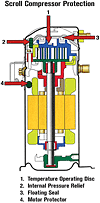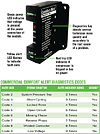
Figure 1. Internal safety controls for a scroll compressor. (Figure Courtesy of Emerson Climate Technologies.)
•Temperature Operated Disc (TOD):A bimetallic disc that senses compressor discharge temperature and opens at 270°F.
•Internal Pressure Relief (IPR):Opens at approximately 400 +/-50-psi differential between high and low side pressures for R-22, and 500 to 625 psi differential for R-410A.
•Floating Seal:Separates the high side from the low side. Also prevents the compressor from drawing into a deep vacuum and damaging (shorting) the Fusite electrical terminal.
•Internal Motor Protection:An inherent protector sensing both internal temperatures and amperages.
Another innovative scroll compressor protection device is used with compressors for better reliability, diagnostic accuracy, speed of service, and reduced callbacks when dealing with compressor systematic troubleshooting. The diagnostic controller installs in the electrical box of a commercial condensing unit, residential unit, or inside a rooftop unit. It is completely self-contained and has no external sensors (Fig. 2).

Figure 2. Diagnostic controller with no external sensors. (Figure Courtesy of Emerson Climate Technologies.)
Phase dropouts, miswiring, and short cycling can also be detected through this device. A flashing light emitting diode (LED) will quickly communicate the alert code and direct the service technician to the problem.
Publication date:12/01/2008


Report Abusive Comment